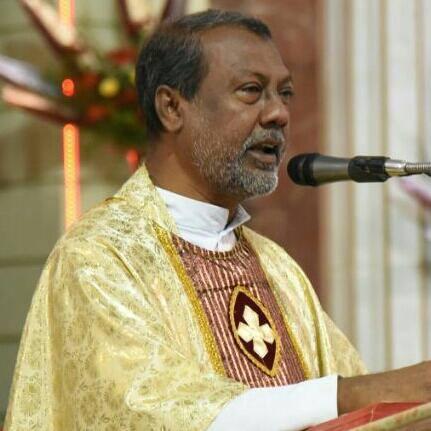|
Archbishop shuts down parish over statue of rebel priest
By Nirmala Carvalho
MUMBAI — Ordinarily, a Catholic bishop anywhere in the world almost certainly would be delighted to see a spontaneous flowering of devotion to a recently deceased local priest. The fact that an archbishop in India actually has shut down a parish rather than allow it to host a statue of one such priest, therefore, suggests circumstances in Bangalore are anything but ordinary. The long-simmering conflict in Bangalore, usually known around the world as India’s IT capital, illustrates how Catholicism here, like the rest of society in the world’s largest democracy, still struggles with often-bitter resentments stoked by class, ethnicity and language. In turn, it’s also a reminder to Western Catholics of why their perceived priorities sometimes don’t resonate in other parts of the world, which have vastly different fires to put out. Last month, Archbishop Bernard Moras of Bangalore ordered the “indefinite” closure of St. Paul the Hermit Church, effective April 21, after the congregation defied his earlier order not to install a statue of the late Father Chowrappa Selvaraj, popularly known as “Father Chasara,” either inside the church or on parish grounds. Moras ordered the current pastor, Father Vincent Santhosh, to remove the Blessed Sacrament from the church, to lock it up for safekeeping, and to present him with a written document certifying that the order had been “fully carried out.” “The church will remain closed until the bust of Father Selvaraj has been removed from the compound, and the parishioners promise in writing to abide by my orders and the laws of the Church,” the decree from Moras stated. “No sacrament may be celebrated in the church till this sanction is lifted,” he added. Selvaraj, who died in March 15 at the age of 60, was every bit as much a lightning rod in life as he’s turning out to be in death. For one thing, he was one of six priests charged in the sensational 2013 murder of Father K.J. Thomas, at the time the rector of St. Peter’s Pontifical Seminary in Bangalore. According to a police spokesman, evidence shows that Selvaraj took part in crucial meetings when the plot against Thomas was hatched, held a week and then just a day before the murder. Investigators believe the motive for the killing was that Thomas was seen as not giving enough prominence to priests who speak Kannada, the language of the ethnic group that founded Bangalore, and that removing him would make way for a more pro-Kannada rector. Moras told Crux, however, that the murder charge was not the reason for his opposition to a statue in Selvaraj’s honor, describing his innocence or guilt as “a matter for the police.” Yet Selvaraj’s pro-Kannada activism is nonetheless at the heart of the conflict, since it’s largely the Kannada-speaking faction within the local Catholic population that has pushed for statues of him in local churches. Selvaraj led a group called the “Association of Kannada Priests of Karnataka,” and was also an officer in another group called the “All Karnataka Kannada Catholic Christians Association.” Among other things, he translated the Bible into Kannada. He was also a leader in the press among Kannada-speaking Catholics to make it the primary liturgical language of the archdiocese, an issue that’s been a thorn in the side of local Church leaders for the better part of four decades. Kannada is the official language of the state in which Bangalore is located, Karnataka, yet estimates are that 70 percent of the local Catholic population actually is composed of ethnic Tamils who arrived from the adjacent Tamil Nadu state. Kannada-speakers in Bangalore believe it should be the dominant language in worship, for reasons of history and cultural identity; Tamils have pressed for wider use of their language, since they’re the largest chunk of Mass-goers; and others want wider use of English, in part because many Catholic children in Banglore attend English-language primary schools. In April 2015, the Vatican’s Congregation for the Evangelization of Peoples issued a ten-point directive attempting to settle the controversy, establishing Kannada as the “principal” language of the archdiocese, yet authorizing pastors to use other languages when circumstances warrant it, and also calling for broader use of English. That didn’t satisfy many Kannada-speaking Catholics, prompting Moras to tell Crux he didn’t want to encourage people who “have been fighting against the Archdiocese of Bangalore for the past 40 years.” “Installing a statue of a priest in the Church compound is in violation of canonical norms, and immortalising the priest, especially by a faction of the people, would demoralise the whole church as well as the faithful,” he said. He noted that since the erection of the diocese in 1940, there’s never been a bust of a local priest in a church. On the other hand, some parishioners have challenged Moras’ authority to issue the decree, noting that the church was not built with the permission of either the bishop or the archdiocese, and it’s never been blessed by the archbishop. Despite the blowback, Moras told Crux he felt it was necessary to nip the devotion to Selvaraj in the bud, in order to try to make a point about Catholic identity being more fundamental than ethnicity and language. “Having consulted my council and people concerned and taken canonical advice, I thought it was prudent to take this painful decision of closing down the church, not because I have anything against the priest, but as a policy decision,” he said. Moras said he hopes over time, the church in Bangalore can get past its divides. “This decision may surprise many,” he said, “but in the Year of Mercy, these are wounds which Jesus will heal, [and] we await with hope and joy the act of reparation.”
|
.
Any original material on these pages is copyright © BishopAccountability.org 2004. Reproduce freely with attribution.
